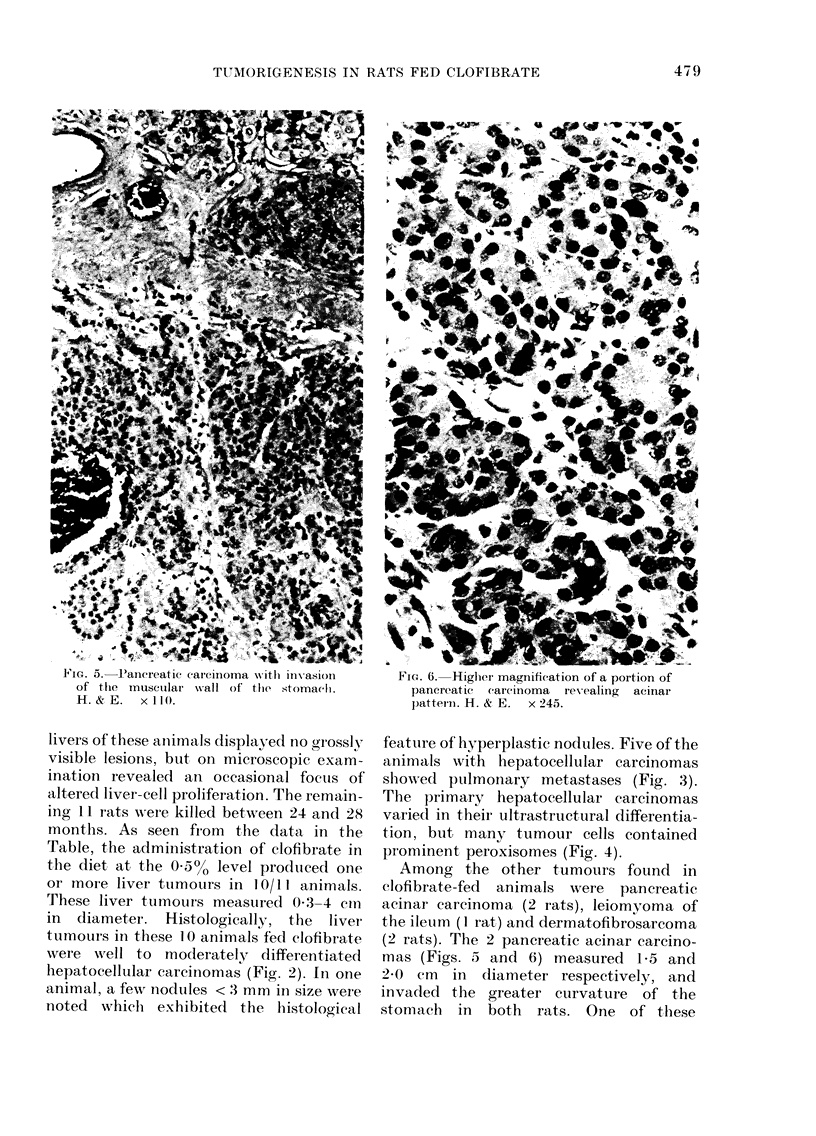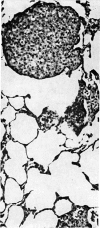Abstract
Ethyl-alpha-p-chlorophenoxyisobutyrate), a hypolipidaemic drug which induces hepatomegaly and proliferation of peroxisomes in liver cells of rats and mice, was fed to 15 male F344 rats at a dietary concentration of 0.5% (v/w) for up to 28 months. Hepatocellular carcinomas developed in 10/11 (91%) rats killed between 24 and 28 months. Other tumours included carcinoma of the pancreas (2 rats), leiomyoma of the small intestine (1 rat) and a large dermatofibrosarcoma (1 rat). Clofibrate is the third hypolipidaemic peroxisome proliferator demonstrated to be hepatocarcinogenic in rats. These studies suggest that hypolipidaemic agents which are capable of producing a sustained hepatomegalic and peroxisome-proliferative effect also induce liver tumours.
Full text
PDF






Images in this article
Selected References
These references are in PubMed. This may not be the complete list of references from this article.
- Carlson L. A., Danielson M., Ekberg I., Klintemar B., Rosenhamer G. Reduction of myocardial reinfarction by the combined treatment with clofibrate and nicotinic acid. Atherosclerosis. 1977 Sep;28(1):81–86. doi: 10.1016/0021-9150(77)90201-5. [DOI] [PubMed] [Google Scholar]
- Hess R., Stäubli W., Riess W. Nature of the hepatomegalic effect produced by ethyl-chlorophenoxy-isobutyrate in the rat. Nature. 1965 Nov 27;208(5013):856–858. doi: 10.1038/208856a0. [DOI] [PubMed] [Google Scholar]
- Lees R. S. Clofibrate and atherosclerosis. N Engl J Med. 1979 Mar 1;300(9):491–492. doi: 10.1056/NEJM197903013000911. [DOI] [PubMed] [Google Scholar]
- McCann J., Choi E., Yamasaki E., Ames B. N. Detection of carcinogens as mutagens in the Salmonella/microsome test: assay of 300 chemicals. Proc Natl Acad Sci U S A. 1975 Dec;72(12):5135–5139. doi: 10.1073/pnas.72.12.5135. [DOI] [PMC free article] [PubMed] [Google Scholar]
- Nigro N. D., Campbell R. L., Gantt J. S., Lin Y. N., Singh D. V. A comparison of the effects of the hypocholesteremic agents, cholestyramine and candicidin, on the induction of intestinal tumors in rats by azoxymethane. Cancer Res. 1977 Sep;37(9):3198–3203. [PubMed] [Google Scholar]
- Novikoff A. B., Goldfischer S. Visualization of peroxisomes (microbodies) and mitochondria with diaminobenzidine. J Histochem Cytochem. 1969 Oct;17(10):675–680. doi: 10.1177/17.10.675. [DOI] [PubMed] [Google Scholar]
- Oliver M. F. Cholesterol, coronaries, clofibrate and death. N Engl J Med. 1978 Dec 14;299(24):1360–1362. doi: 10.1056/NEJM197812142992409. [DOI] [PubMed] [Google Scholar]
- Reddy B. S., Weisburger J. H., Wynder E. L. Effects of dietary fat level and dimethylhydrazine on fecal acid and neutral sterol excretion and colon carcinogenesis in rats. J Natl Cancer Inst. 1974 Feb;52(2):507–511. doi: 10.1093/jnci/52.2.507. [DOI] [PubMed] [Google Scholar]
- Reddy J. K., Azarnoff D. L., Svoboda D. J., Prasad J. D. Nafenopin-induced hepatic microbody (peroxisome) proliferation and catalase synthesis in rats and mice. Absence of sex difference in response. J Cell Biol. 1974 May;61(2):344–358. doi: 10.1083/jcb.61.2.344. [DOI] [PMC free article] [PubMed] [Google Scholar]
- Reddy J. K., Krishnakantha T. P. Hepatic peroxisome proliferation: induction by two novel compounds structurally unrelated to clofibrate. Science. 1975 Nov 21;190(4216):787–789. doi: 10.1126/science.1198095. [DOI] [PubMed] [Google Scholar]
- Reddy J. K., Rao M. S. Enhancement by Wy-14,643, a hepatic peroxisome proliferator, of diethylnitrosamine-initiated hepatic tumorigenesis in the rat. Br J Cancer. 1978 Oct;38(4):537–543. doi: 10.1038/bjc.1978.241. [DOI] [PMC free article] [PubMed] [Google Scholar]
- Reddy J. K., Rao M. S. Malignant tumors in rats fed nafenopin, a hepatic peroxisome proliferator. J Natl Cancer Inst. 1977 Dec;59(6):1645–1650. doi: 10.1093/jnci/59.6.1645. [DOI] [PubMed] [Google Scholar]
- Reddy J. K., Rao S., Moody D. E. Hepatocellular carcinomas in acatalasemic mice treated with nafenopin, a hypolipidemic peroxisome proliferator. Cancer Res. 1976 Apr;36(4):1211–1217. [PubMed] [Google Scholar]
- Reddy J., Bunyaratvej S., Svoboda D. Microbodies in experimentally altered cells. IV. Acatalasemic (CSb) mice treated with CPIB. J Cell Biol. 1969 Aug;42(2):587–596. doi: 10.1083/jcb.42.2.587. [DOI] [PMC free article] [PubMed] [Google Scholar]
- STAMLER J., LINDBERG H. A., BERKSON D. M., SHAFFER A., MILLER W., POINDEXTER A. Prevalence and incidence of coronary heart disease in strata of the labor force of a Chicago industrial corporation. J Chronic Dis. 1960 Apr;11:405–420. doi: 10.1016/0021-9681(60)90046-1. [DOI] [PubMed] [Google Scholar]
- Sass B., Rabstein L. S., Madison R., Nims R. M., Peters R. L., Kelloff G. J. Incidence of spontaneous neoplasms in F344 rats throughout the natural life-span. J Natl Cancer Inst. 1975 Jun;54(6):1449–1456. doi: 10.1093/jnci/54.6.1449. [DOI] [PubMed] [Google Scholar]
- Svoboda D. J., Azarnoff D. L. Response of hepatic microbodies to a hypolipidemic agent, ethyl chlorophenoxyisobutyrate (CPIB). J Cell Biol. 1966 Aug;30(2):442–450. doi: 10.1083/jcb.30.2.442. [DOI] [PMC free article] [PubMed] [Google Scholar]
- THORP J. M., WARING W. S. Modification of metabolism and distribution of lipids by ethyl chlorophenoxyisobutyrate. Nature. 1962 Jun 9;194:948–949. doi: 10.1038/194948a0. [DOI] [PubMed] [Google Scholar]
- THROP J. M. Experimental evaluation of an orally active combination of androsterone with ethyl chlorophenoxy-isobutyrate. Lancet. 1962 Jun 23;1(7243):1323–1326. doi: 10.1016/s0140-6736(62)92423-6. [DOI] [PubMed] [Google Scholar]
- Warren J. R. Damage of proliferating lymphoid cell deoxyribonucleic acid by methyl methanesulfonate and N-acetoxy-2-acetylaminofluorene. Cancer Lett. 1978 Nov;5(5):253–260. doi: 10.1016/s0304-3835(78)80022-6. [DOI] [PubMed] [Google Scholar]
- Yeshurun D., Gotto A. M., Jr Drug treatment of hyperlipidemia. Am J Med. 1976 Mar;60(3):379–396. doi: 10.1016/0002-9343(76)90755-5. [DOI] [PubMed] [Google Scholar]







